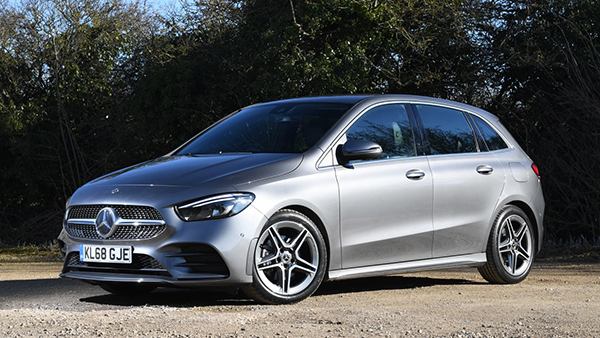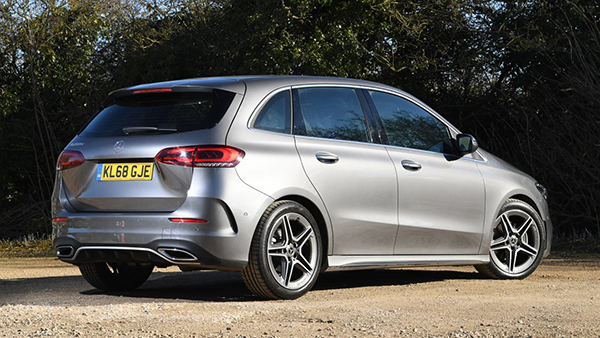Mercedes is a master of creating and blurring model sectors, with the B-Class a prime example of being difficult to define. Is it a family hatch or an MPV? The simple answer is that it features elements of both, and it’s no less desirable because of this; if you want a high-quality hatch that offers an extra dose of usability, thanks to its roomier-than-average cabin, look no further. Think of it as a high-roof A-Class. While that does give it something of an identity crisis, we’re big fans of Mercedes’ smallest car, so using that as the basis for something with added practicality is no bad thing.

It’s a fact of life that there will always be cars that are perfectly good at what they do – perhaps even impressive in some ways – yet they still fly below the radar for most consumers. Take the Mercedes B-Class as an example.
The first edition arrived back in 2005, and by the time its successor went on sale seven years later, the B-Class was still a car that many buyers knew nothing about. Five years since the Mk3 was unveiled, it’s fair to say that even now, in a bewilderingly wide model line-up, it still isn’t uppermost in people’s minds. But that doesn’t mean it shouldn’t be on your used-buy shortlist, because the Mercedes is a car with many talents.
History
The B-Class Mk3 reached UK showrooms in April 2019, the year after it had been unveiled. There was a choice of two trim levels (Sport and AMG Line), along with four engines. Petrol fans could choose between the 132bhp B 180 and the 159bhp B 200, both of which featured a 1.3-litre powerplant.
Those who preferred diesel could pick between the 146bhp B 200 d and the 185bhp B 220 d, each with a 2.0-litre engine; the 115bhp 1.5-litre B 180 d arrived soon after. Meanwhile, the B 250 e plug-in hybrid joined the range in September 2020, with a 156bhp 1.3-litre petrol powerplant backed up by a 100bhp electric motor.
A facelifted B-Class arrived at the end of 2022, with three engine choices: B 200, B 200 d, B 250 e. An improved infotainment system was fitted, and the B 200 got mild-hybrid tech, extra trim options and LED lighting front and rear.

Which one should I buy?
None of the engines feels weak, and there’s a reasonably plentiful supply of petrols and diesels, so any of these are worth owning. The plug-in hybrid is impressive, but you’ll pay a significant premium – and while the pay-off can be cheaper motoring, how and where you drive could make all the difference as to whether or not you’ll get any of that money back.
Whichever B-Class you buy, it’ll be well equipped, with the Sport having 17-inch alloys, LED headlights, a powered tailgate, keyless go, dual-zone climate control and a seven-inch touchscreen. The AMG Line gets 18-inch wheels, privacy glass, sports seats and a bodykit. Executive trim boasts heated front seats plus front and rear parking sensors; Premium Plus adds a panoramic glass roof and adaptive headlights.
Alternatives to the Mercedes B-Class
Five-seat not-quite-MPVs are pretty thin on the ground, with only the BMW 2 Series Active Tourer in contention. The Volkswagen Golf SV and Toyota Prius+ used to occupy this territory, but they were both killed off in 2020, within months of the B-Class Mk3 being launched. The BMW is worth a look, though, with its high-quality cabin, great engines and slick infotainment systems.
If you’d like an extra couple of seats, BMW can help again, with the 2 Series Gran Tourer, but this is up against an array of seven-seat alternatives such as the VW Touran, Citroen Grand C4 SpaceTourer and Ford S-MAX. While the VW focuses on quality and great engines, the Citroen majors on value and equipment, and the Ford is the most enjoyable to drive.

What to look for
Hybrid range
The B 250 e has a 15.6kWh battery pack, for which up to a 42-mile range on electric only is claimed. Expect 35 miles in reality.
Drive on
Mercedes offered its 4MATIC four-wheel-drive transmission, but only with the B 220 petrol engine. It’s a very rare edition on the used market.
Child seats
The B-Class is family friendly, but if you need three child seats in the back, you’ll be disappointed – there are only two Isofix mountings.
Wheel life
While the B-Class doesn’t come with a spare wheel of any kind and Mercedes doesn’t offer one, space-savers are available independently.
Gearbox
There used to be a belief that you don’t buy a Mercedes with a manual gearbox, because the automatic alternative was always nicer to live with and easier to sell on. The B-Class’s manual transmission is fine on the road, but it’s rare and you’ll definitely find it harder to sell on.
Interior
If you’re moving up from an A-Class, you’ll feel at home in the B-Class, because the dashboard is much the same, meaning it’s hi-tech and user friendly. The quality is impressive, while the large touchscreens and digital instrumentation give the Mercedes a contemporary feel. If you’re a fan of voice control, you’ll love the Merc’s MBUX user interface, which is one of the best.
Space is excellent with room for five adults, and the boot is 455 litres, or 1,530 with the seats down; mild hybrids cut this to 420 and 1,505 litres.
Prices
There are similar numbers of B 200s and B 200 ds for sale, and these account for most of the B-Classes on the used market; the B 250 e is more unusual. By far the most popular trim is AMG Line.

Running costs
The service interval for all third-generation B-Classes is 12,500 miles or 12 months, with work alternating between minor and major. However, each service is priced differently according to what parts need to be replaced. As a result, the minor work can be anywhere from £340-£873, whereas the major service is typically pegged at around £450.
The brake fluid should be refreshed every two years (£106), while the auto gearbox oil should be renewed every five years or 75,000 miles, at £322. All engines are chain driven, so there are no cambelts to replace.
Recalls
The B-Class Mk3 has been the subject of 10 recalls – but incredibly, no fewer than six of these, all issued in May 2021, were because of problems with the eCall system. Most of Mercedes’ models were affected, across a wide range of cars built between January 2016 and January 2021. Before this, in October 2020, some petrol-engined B-Classes were recalled because of engine-oil leaks; two weeks later, diesel-powered models were subject to their own campaign because of faulty engine-control units.
The most recent recall was issued in March 2022, because some B-Classes left the factory with faulty brakes; two months earlier, an action was launched due to some cars being built with door-lock glitches. In each case, all of these recalls affected several models in Mercedes’ range, including the A-Class and GLA.
Driver Power owner satisfaction
The B-Class hasn’t featured in our Driver Power surveys, but plenty of Mercedes models have. They rarely trouble the top 30; mid-table is normal. The A-Class managed 39th in the 2023 new-car survey, while the E-Class was four places behind; last year the brand’s best result was 30th for the A-Class. Only one owner has left a review on carbuyer.co.uk, awarding the B-Class two stars out of five.
Mercedes-Benz B-Class W247 A High Class MPV With Few Rivals
22/11/2023
No Comments
Mercedes-Benz | Mercedes-AMG
Click to rate this post
[Total: 1 Average: 5]